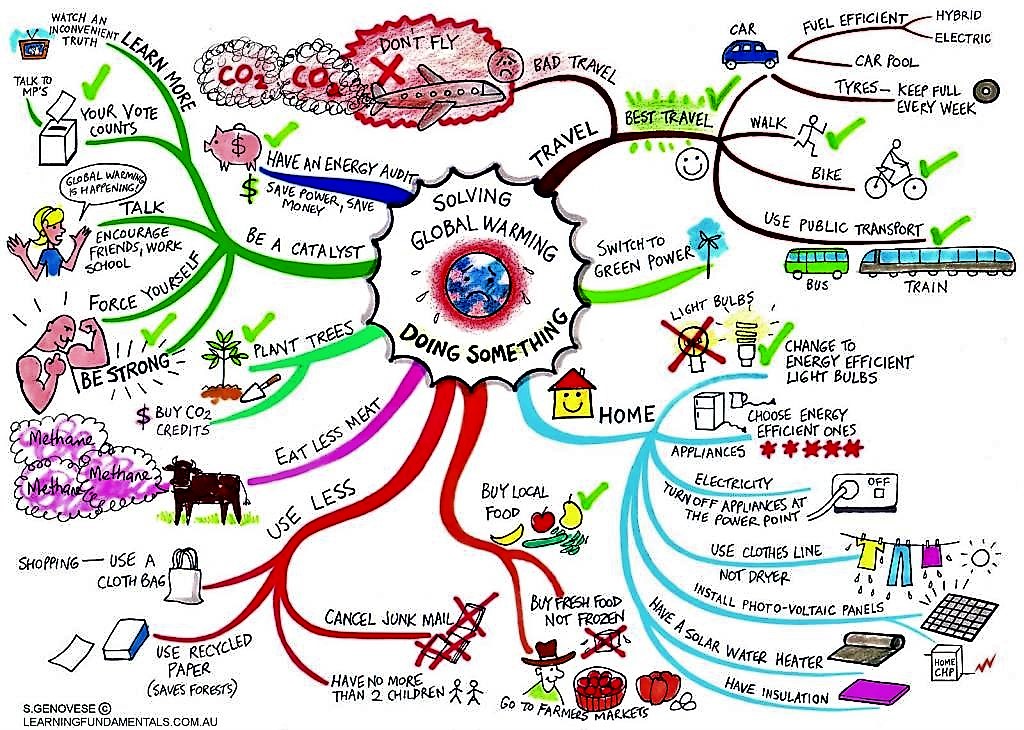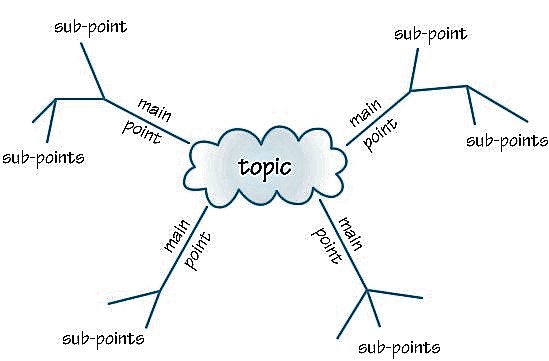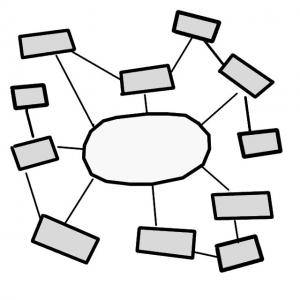Executive Summary
Mind mapping is a diagram technique to generate, visualise, structure and class-ify ideas, and is used as an aid to organising information and solving problems (ABS et al. 2000). The key word or main idea located in the centre of a mind map is the starting point for branches with subtopics (ideas, tasks, etc.), which can be further differentiated into other branches. By using mind maps, you can quickly gather ideas or understand the structure of a subject. You can see the way that pieces of information fit together, as well as recording the raw facts contained in normal notes. More than this, mind maps encourage creative problem solving, as they hold information in a format that your mind finds easy to remember and quick to review (MIND TOOLS 2011).
What Is Mind Mapping?
A mind map is a diagram used to represent ideas, words, tasks, or other items linked to and arranged around a central key word or idea. Mind maps are used to generate, visualise, structure and classify ideas, and as an aid to studying and organising information, solving problems, making decisions, and writing. The elements of a given mind map are arranged intuitively according to the importance of the concepts, and are classified into branches or areas, with the goal of representing connexions between portions of information. Their visual basis helps you to distinguish words or ideas, often with colours and symbols. They generally take a hierarchical or tree branch format, with ideas branching into their subsections (WIKIPEDIA 2011).

By using mind maps, you can quickly identify and understand the structure of a subject, the relative importance of individual points, and the way in which facts relate to one another. You can see the way that pieces of information fit together, as well as recording the raw facts contained in normal notes. More than this, mind maps hold information in a format that your mind finds easy to remember and quick to review (MIND TOOLS 2011).
By presenting ideas in a radial, graphical, non-linear manner, mind maps encourage a brainstorming approach to planning and organisational tasks. They allow for greater creativity when recording ideas and information, as well as allowing the note-taker to associate words with visual representation. This orientation towards brainstorming encourages users to enumerate and connect concepts without a tendency to begin within a particular conceptual framework (WIKIPEDIA 2011).
Mind mapping can be done in groups (see group works) or on your own – sometimes it is even more effective, as you are not influenced by what other people may think of your ideas. You may not, however, develop ideas as fully when you do this on your own, as you do not have the wider experience of other members of a group to help you.
When to Use Mind Mapping
- Gathering ideas
- Analysing a topic
- Summarising information and note-taking
- Consolidating information from different sources
- Thinking through complex problems
- Presenting information in a format that shows the overall structure of your subject
- Preparing a presentation
Steps to Create a Mind Map
(Adapted from FEWINGS 2011; MIND TOOLS 2011; WILLIAMS 1998)

- Start:Begin with a huge piece of paper and turn it sideways (into “landscape” orientation). This provides most space for writing (which tends to go from left-to-right rather than top-to-bottom). Try to write most of your words in a generally horizontal direction.
- Topic: Write the title of the subject you're exploring in the centre of a page, and draw a circle around it. Alternatively, you can draw an image that represents the main theme, which acts as the visual anchor for the topic.
- Main-branches: Now search for important facts that relate to the subject. As you come across major subdivisions of the topic, draw “main-branches” for each of your main sub-themes, using different colours for each branch, and write the word along the branch. It may be helpful to brainstorm (see brainstorming) sub-themes and associated ideas before committing them to the map.
- Sub-branches: As you uncover another level of information (further subheadings, or facts) belonging to the subheadings above, draw these as lines linked to the subheading lines. Write the word along the sub-branch.
- Evaluation: If you are working with a group, discuss the mind map with the participants and evaluate the outcome. You may want to re-work your original mind map so that you get it “just right”.
Work on each of these branches systematically or jump about all over the place – but try to organise each new idea so that it connects with previous ideas. If ideas recur in different parts of the map, that’s OK (FEWINGS 2011). As you can imagine, mind maps can become complex but exciting revision tools which allow the participants (and you) to build up links between the main topics of the map.
Improving your Mind Maps
(Adapted from MIND TOOLS 2011)
The following suggestions may help to increase the effectiveness of your mind maps:
- Use single words for information: Most words in normal writing are padding, as they ensure that facts are conveyed in the correct context, and in a format that is pleasant to read. In your own mind maps, single strong words can convey the same meaning more potently.
- Use colour to separate different ideas: This will help you to separate ideas where necessary. It also helps you to visualise the mind map for recall. Colour also helps to show the organisation of the subject.
- Use symbols and images: Where a symbol or picture means something to you, use it. Pictures can help you to remember information more effectively than words.
- Only use plat tip markers(thin tip markers are hard to read).
- Make the lines the same length as the word.
- Using cross-linkages: Information in one part of the mind map may relate to another part. Here you can draw in lines to show the cross-linkages. This helps you to see how one part of the subject affects another.
Mind Mapping Software
Mind mapping software can be used effectively to organise large amounts of information, combining spatial organisation, dynamic hierarchical structuring and node folding. Software packages can extend the concept of mind mapping by allowing individuals to map more than thoughts and ideas with information on their computers and the internet, like spreadsheets, documents, internet sites and images. Online-tools enable you to create mind maps directly on the internet in a collaborative working environment, where you can work together with colleagues irrespective of their geographical location.
In the context of gathering ideas to make water management and sanitation more sustainable, mind mapping can be used by individuals or by groups to gather ideas or understand the structure of a topic. It is an appropriate technique for simple tasks, such as writing a memo, as well as for complex tasks, such as getting a shared perspective of a complex project. Because the process is not very time-consuming and you do not need a lot of material, mind mapping is an option in almost every situation in your decision-making process.
When working in a group, mind mapping provides a freewheeling environment in which everyone is encouraged to participate. Quirky ideas are welcomed, and many of the issues of group problem solving are overcome. All participants are asked to contribute fully and fairly, liberating people to develop a rich array of creative solutions to the problems they are facing (MIND TOOLS 2010).
Besser Lehren. Praxisorientierte Anregungen und Hilfen für Lehrende in Hochschulen und Weiterbildung
Live the Solution. Mind map 1: Combating global warming
Mind Maps. A Powerful Approach to Note-Taking
Skills for OU Study. Mind map example
Mind Mapping. Teaching Ideas
RAPID Toolkit - Tools for Knowledge and Learning: A guide for development and humanitarian organisations
This toolkit of the Research and Policy in Development (RAPID) programme presents entry points and references to the wide range of tools and methods that have been used to facilitate improved knowledge and learning in the development and humanitarian sectors. On pages 52-54 you can find a detailed description of the mind mapping process and an example of how it has been successfully applied in Dar-es-Salaam, Tanzania.
RAMALINGAM, B. (2006): RAPID Toolkit - Tools for Knowledge and Learning: A guide for development and humanitarian organisations. London: Overseas Development Institute URL [Accessed: 12.04.2011]Mind Mapping. Learning Guide
This four-page document provides good advice on how to use mind mapping, presents some nice examples and describes the benefits of using mind maps.
VELLIARIS, D. (2009): Mind Mapping. Learning Guide. Aidelade: The University of Adelaide URL [Accessed: 07.07.2019]MindTools - Management Training and Leadership Training, Online
A very useful site that contains an extensive description of mind mapping and information on other techniques. It also describes methods to improve the classical mind mapping technique.
Mind Maps and Mind Mapping
The website “Creativity Web” is a resource centre giving you information about mind mapping and other techniques to help you become more creative. Resources are nu-merous and include books, software, websites and short videos.
List of concept- and mind-mapping software
This wikipedia-page presents a list of notable mind mapping software. Mind mapping software can be used effectively to organise large amounts of information, combining spatial organisation, dynamic hierarchical structuring and node folding. Software packages can extend the concept of mind mapping by allowing individuals to map more than thoughts and ideas with information on their computers and the internet, like spread-sheets, documents, internet sites and images.
XMind - Mind Mapping Software
XMind is an open source brainstorming and mind mapping software tool developed by XMind Ltd. The programme is intended to assist users in capturing ideas, organising various charts, and share them with collaborators. It supports mind maps, fishbone dia-grams, tree diagrams, organisation charts and spreadsheets.
Spicynodes
SpicyNodes is free online software to visualise online information. It can be used for everything from mind maps and content portals to organisational charts and lesson plans.


